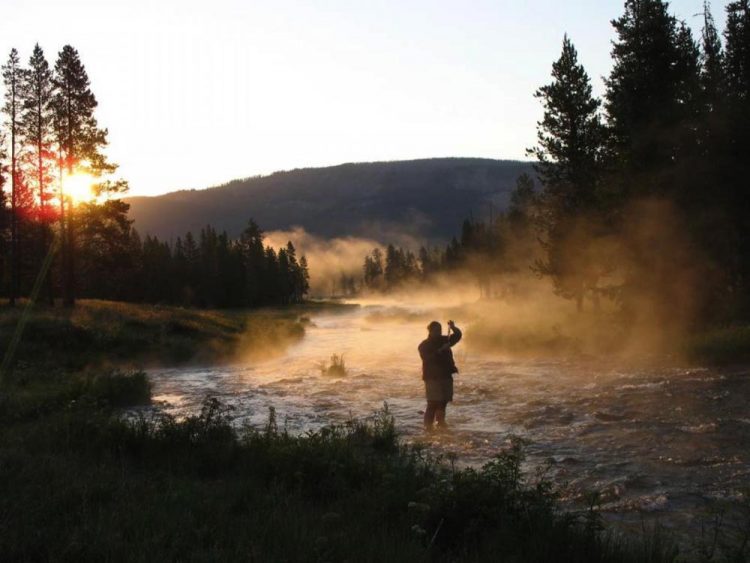CO2 emissions change with size of streams and rivers

This is a sampling from one of the Wyoming study sites. Credit: Erin Hotchkiss
Now, researchers have shown that the greenhouse gas appears in streams by way of two different sources — either as a direct pipeline for groundwater and carbon-rich soils, or from aquatic organisms releasing the gas through respiration and natural decay.
CO2's origins — land or life — depend largely on the size of the stream or river, according to a paper published Aug. 10 in Nature Geosciences. These findings shed light on the role freshwater rivers play in the global carbon cycle.
“This paper validates that in certain systems, a lot of the carbon dioxide is coming from terrestrial systems, but as you get to larger rivers, that connection to the land becomes less and less strong. This is the first broad study to show that,” said co-author David Butman, a University of Washington assistant professor of environmental and forest sciences and of civil and environmental engineering.
The researchers found that smaller streams usually carry carbon dioxide that is produced by plants on land and then transferred to the water by way of soil and groundwater. That happens because at its headwaters, a small stream often is surrounded by trees and other plants that pull carbon out of the atmosphere and store or “sink” it in soils and biomass.
But in larger streams, most CO2 emissions are produced directly in the water itself. More plants and animals are present in larger rivers, and they use available oxygen and convert organic carbon to carbon dioxide through respiration.
Understanding how carbon dioxide ends up in streams and rivers will improve predictions of how changes to river systems affect the efficiency of terrestrial ecosystems at removing greenhouse gases from the atmosphere, researchers say.
“It is very important to know the sources of carbon dioxide in running waters as well as the processes controlling respiration and emissions if we are to understand what happens when the environment changes,” said lead author Erin Hotchkiss, who completed the research while at Umeå University in Sweden.
Butman and Hotchkiss, along with other collaborators at Umeå University and the University of Wyoming, began working together about two years ago to see if they could pinpoint where the carbon dioxide measured in rivers and streams was coming from.
The researchers looked at long-term U.S. Geological Survey data from about 1,400 freshwater streams and rivers across the U.S., as well as data collected from more than 180 river monitoring sites. Their models showed that aquatic plants and animals produced about 30 percent of the carbon dioxide found in streams and rivers in the U.S. on average, and that number ranged from only 14 percent in the smallest streams to near 40 percent in large rivers.
The main takeaway, Butman said, is that rivers and streams don't all behave the same way with regard to putting out carbon dioxide. This study is one of the first attempts to identify the source of carbon in freshwater river systems at a very large scale, helping to further our understanding of the role streams and rivers play in the global carbon cycle.
“Figuring out how these streams fit into the larger carbon cycle is most important,” he said.
The next step is to take the research beyond modeling and do actual broad-scale measurements of CO2 along entire networks of streams, Butman added.
###
Other co-authors are Robert O. Hall Jr. at the University of Wyoming; and Ryan Sponseller, Jonatan Klaminder, Hjalmar Laudon, Martin Rosvall and Jan Karlsson at Umeå University.
This research was funded by Kempestifelserna, a foundation in Sweden, with additional data and analysis support through Butman and the U.S. Geological Survey's LandCarbon Program.
For more information, contact Butman at dbutman@uw.edu or 206-685-0953.
Related paper: http://www.
Media Contact
All latest news from the category: Earth Sciences
Earth Sciences (also referred to as Geosciences), which deals with basic issues surrounding our planet, plays a vital role in the area of energy and raw materials supply.
Earth Sciences comprises subjects such as geology, geography, geological informatics, paleontology, mineralogy, petrography, crystallography, geophysics, geodesy, glaciology, cartography, photogrammetry, meteorology and seismology, early-warning systems, earthquake research and polar research.
Newest articles

NASA: Mystery of life’s handedness deepens
The mystery of why life uses molecules with specific orientations has deepened with a NASA-funded discovery that RNA — a key molecule thought to have potentially held the instructions for…

What are the effects of historic lithium mining on water quality?
Study reveals low levels of common contaminants but high levels of other elements in waters associated with an abandoned lithium mine. Lithium ore and mining waste from a historic lithium…

Quantum-inspired design boosts efficiency of heat-to-electricity conversion
Rice engineers take unconventional route to improving thermophotovoltaic systems. Researchers at Rice University have found a new way to improve a key element of thermophotovoltaic (TPV) systems, which convert heat…



